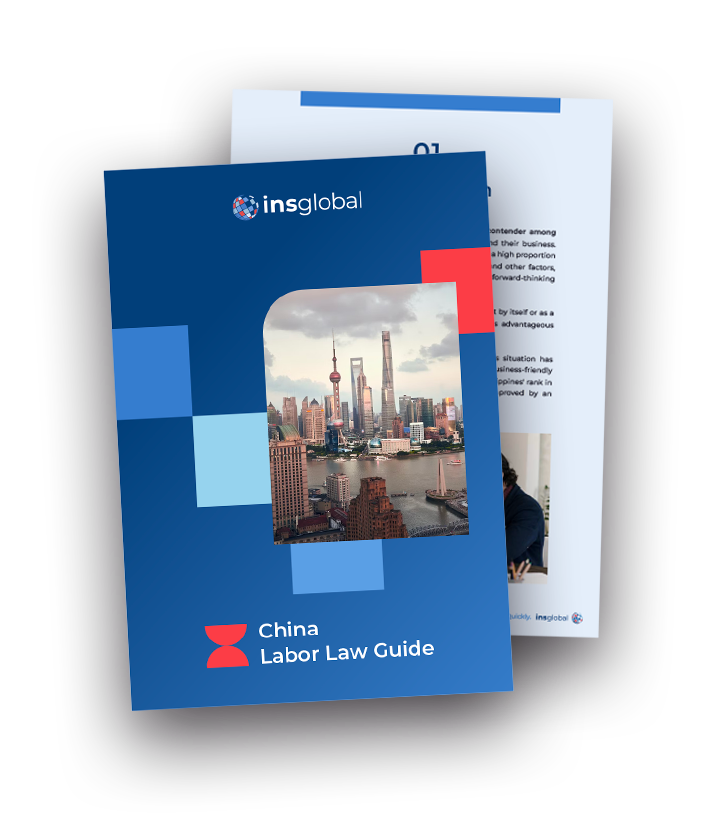Understand how the legal and fiscal system is applied in China and which are the requirements to be compliant for foreign companies. Let INS Global guide you through the process of expansion in China.

Tired of scrolling? Download a PDF version for easier offline reading and sharing with coworkers
In a hurry? Save this article as a PDF
Tired of scrolling? Download a PDF version for easier offline reading and sharing with coworkers.
Fill up the form below 👇🏼
Calculating a Business’s Taxable Income in China
Introduction on Business Taxes in China
The corporate tax rate in China, officially known as the Enterprise Income Tax (EIT), is a standard 25% unless the company participates in strategic industry or regional promotion programs. The Enterprise Income Tax is calculated on profits, capital gains, and passive income (including, but not limited to interest, royalties and rents). A company’s taxable income is defined as the amount of gross income remaining after deductions of qualified expenses, depreciation and losses.
Taxable Income
- Less Non-taxable Income
- Less Exempt Income
- Less Deductible Expenses
- Less Losses
Net Income
Under China’s corporate tax law, net income for Chinese companies (whether domestic or foreign-owned) includes:
- Profits
- Capital gains
- Passive income
- Dividends from a foreign entity
Check Our China Labor Law Guide
Learn how the Chinese law is applied in all aspects and situations, from an employer and employee perspective

Tax Resident Enterprises (TRE)
A Tax Resident Enterprise is one that is registered or managed in China. The global income of a TRE is subject to EIT.
Income in Foreign Currency
This should be calculated in RMB for assessing net income.
Non-TRE
For non-TREs, the company is only subject to EIT on its China-sourced income. The company is subject to a withholding tax on the following types of income:
- Dividends (dividends paid out on profits earned before 2008 are exempt)
- Royalties
- Rents
- Interest
Step 1: Subtract Non-Taxable Income
A company may or may not have non-taxable income to subtract. The current corporate tax law has largely eliminated income in this category.
Step 2: Subtract Exempt Income
There are unlikely to be many instances in which there is exempt income to subtract.
Step 3: Deduct Business Expenses
Business costs associated with taxable income are deductible as long as they are well documented (usually with a fapiao, the official receipt). Examples of deductible expenses include:
- Capital expenditure on fixed assets
- Machinery maintenance, refurbishment, and replacement costs
- Rent paid for offices or facilities
- IP registration costs
- Expenses related to borrowing cash
- Pension and social insurance contributions
- Expenses related to acquiring intangible assets such as patents, copyrights, and trademarks
- Salary expenses (not management fees)
R&D Expenses for New Technology and New Products
These R&D expenses are “super-deductible”, meaning, in this case, that 150% of the value of incurred expenses are deductible.
Salaries for Handicapped Employees
Salaries on these employees are super-deductible, where 200% of their salary is deductible.
Cost Sharing
Cost sharing among related parties is permitted for intangible assets developed by said parties as well as for common services (such as group procurement and company strategy advising). The sharing must be conducted at arms length.
Limits on Expenses
- Entertainment: Expenses on entertainment are only 60% deductible and limited to up to 0.5% of income.
- Advertising: Advertising expenses are deductible up to 15% of the sales income of the enterprise.
- Donations: Deductible up to 12% of accounting profit.
Inventory Valuation
All inventory must valued according to one of the following three valuation methods: first-in-first-out, specific identification or weighted average.
Thin Capitalization Rule for Interest Payments
The thin capitalization rule limits the deductions for payments related to financing from related parties. The thin capitalization rule for financial institutions specifies a debt-to-equity ratio of 5:1. For other businesses, the threshold is a debt-to-equity ratio of 2:1. Interest payments to related parties beyond this threshold are not deductible. However, if the company can document that the financing is conducted at arms-length or that the tax-rate of the lending entity is not lower than the Chinese borrowing entity, related-party financing beyond the threshold may be permitted.
Non-deductible Items
- Management fees: If charged at arms length, service fees paid to affiliates in China or abroad are deductible.
- Earned Income Tax paid and all related charges (e.g. late payment surcharges).
- Fines and losses related to unlawful business operations.
- Payments regarding equity interests to investors such as dividends. Such payments are deductible, however, if they are paid to affiliates in China or overseas.
Step 4: Deduct Depreciation of Assets
Accelerated Depreciation
A reduced depreciation life is permitted in some cases, when well documented and proven, including:
Abrupt technological advancement or significant change in technical standards, reducing the value of the technology or limiting its future contribution to generating business income.
Machinery suffering from constant vibration or erosion.
Intangible Assets
The straight-line method should be used to amortize intangible assets. They should be amortized either over a period of 10 or more years or over the time limit specified in the contract governing use of the asset.
- Purchased Goodwill Purchased Goodwill is not deductible unless the enterprise has been liquidated or transferred. Purchased goodwill is defined as:
(value paid for enterprise as going concern) – (sum of assets – liabilities)
Step 5: Deduct Losses
Losses, including asset losses and bad debt losses are deductible in the year in which the losses took place.
Tax Loss Carryovers
Tax losses may be carried over for up to five years

SHARE